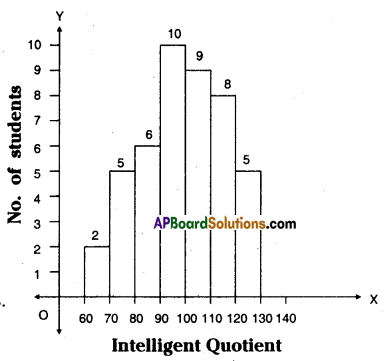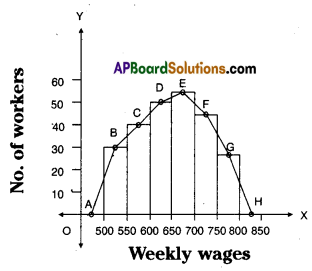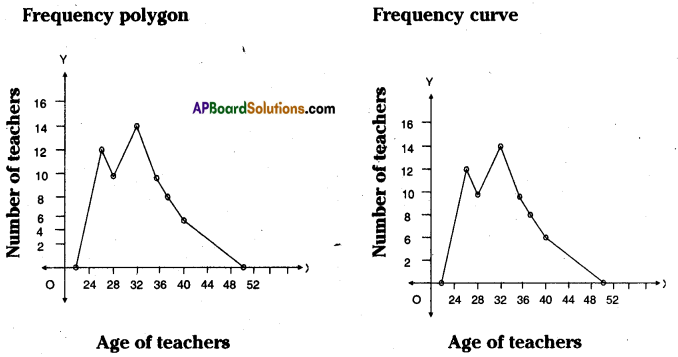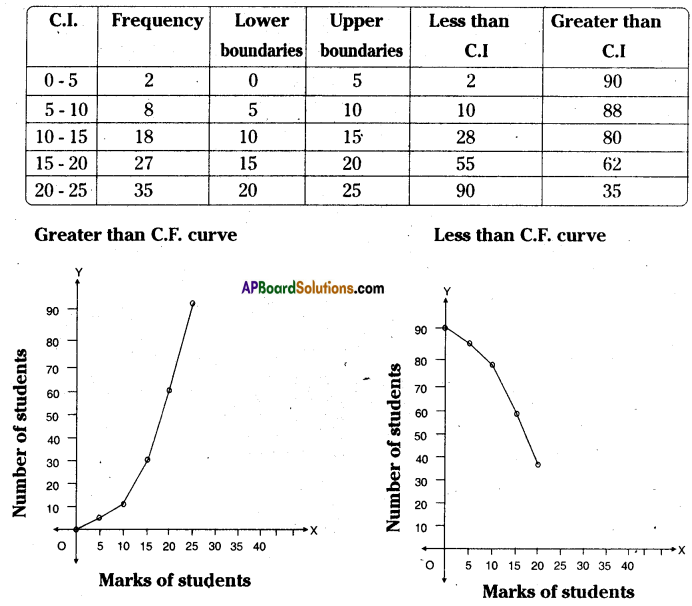AP State Syllabus AP Board 8th Class Maths Solutions Chapter 7 Frequency Distribution Tables and Graphs Ex 7.3 Textbook Questions and Answers.
AP State Syllabus 8th Class Maths Solutions 7th Lesson Frequency Distribution Tables and Graphs Exercise 7.3
![]()
Question 1.
The following table gives the distribution of45 students across the different levels of intelligent Quotient. Draw the histogram for the data.

Solution:

Steps of construction:
1. Calculate the difference between mid values of two consecutive classes
∴ h = 75 – 65 = 10
∴ Class interval (C.I) = 10
2. Select such a right scale
on X-axis 1 cm = 10 units
on Y-axis 1 cm 1 student
3. Construct a histogram with C.Is as width and frequencies as lengths.
![]()
Question 2.
Construct a histogram for the marks obtained by 600 students in the VII class annual
examinations.

Solution:
Classes will be prepared on class marks.
Step – 1: Take the difference between the mid values of two consecutive classes.
∴ h = 400 – 360 = 40
Step – 2: Let the lower and upper boundaries be taken as x – [latex]\frac{h}{2}[/latex] , x + [latex]\frac{h}{2}[/latex]
∴ x – [latex]\frac{h}{2}[/latex] = 360 – [latex]\frac{40}{2}[/latex] = 360 – 20 = 340
x + [latex]\frac{h}{2}[/latex] = 360 + [latex]\frac{40}{2}[/latex] = 360 + 20 = 380
Step – 3 : Select the scale
on X-axis 1 cm = 1 C.I (mid values)
on Y-axis 1 cm = 20 students
Step – 4 : Take C.I’s as width, frequencies as lengths.
Then construct the histogram.
| Class Marks | Class Interval | Frequency |
| 360 | 340- 380 | 100 |
| 400 | 380- 420 | 125 |
| 440 | 420-460 | 140 |
| 480 | 460-500 | 95 |
| 520 | 500-540 | 80 |
| 560 | 540-580 | 60 |
Scale : On Y – axis no. of students = 20, On X – axis take marks of students.

![]()
Question 3.
Weekly wages of 250 workers in a factory are given in the following table. Construct the histogram and frequency polygon on the same graph for the data given.
using the histogram. (Use separate graph sheets)

Solution:
| Class Interval (Weekly wages) |
Frequency (No. of workers) |
Mid values |
| 500-550 | 30 | 525 |
| 550-600 | 42 | 575 |
| 600-650 | 50 | 625 |
| 650-700 | 55 | 675 |
| 700-750 | 45 | 725 |
| 750 -800 | 28 | 775 |
| N = 250 |
Steps of constructIon:
- C.I. = Difference of two consecutive mid values = h = 575 – 525 = 50
- Scale : On X-axis 1 cm = ₹ 50
On Y-axis 1 cm = lo members - Take on X-axis width of C.I, on Y-axis frequncies.
- Keep points A, B, C, D, E, F, G, H on the mid points of rectangles.
- The area of a histogram is equal to the area of a polygon.

![]()
Question 4.
Ages of 60 teachers in primary schools of a Mandai are given in the following frequency distribution table. Construct the Frequency polygon and frequency curve for the data without using the histogram. (Use separate graph sheets)

Solution:
Construction of frequency polygon:
- Class interval = The difference between two mid values of classes
= 30 – 26 = 4 - Scale : On X-axis take the age of teachers
On Y-axis take number of teachers. - Scale: On X-axis 1 cm = 4units
On Y- axis 1 cm = 2 units - Take the widths of classes on X – axis. Frequencies on Y – axis.
- The points are formed on the graph sheet are joined by a scale then the required frequency polygon and if the points are joined by hand frequency curve will be formed.

![]()
Question 5.
Construct class intervals and frequencies for the foliowing distribution tabie. Also draw the ogive curves for the same.

Solution:
Steps of constructIon:
Step – 1: If the given frequency distribution is in inclusive form, then convert it into an
exclusive form.
Step – 2: Calculate the less than cumulative frequency.
Step – 3: Mark the upper boundaries of the class intervals along X-axis and their corresponding cumulative frequencies along Y-axis.
Select the scale:
X – axis 1 cm = 1 class interval
Y – axis 1 cm = 10 students
Step – 4: Also, plot the lower boundary of the first class (upper boundary of the class previous to first class) interval with cumulative frequency 0.
Step – 5: Join these points by a free hand curve to obtain the required ogive.
Similarly we can construct ‘greater than cumulative frequency curve by taking greater than cumulative on Y – axis and corresponding ‘lower boundaries’ on the
X-axis.
